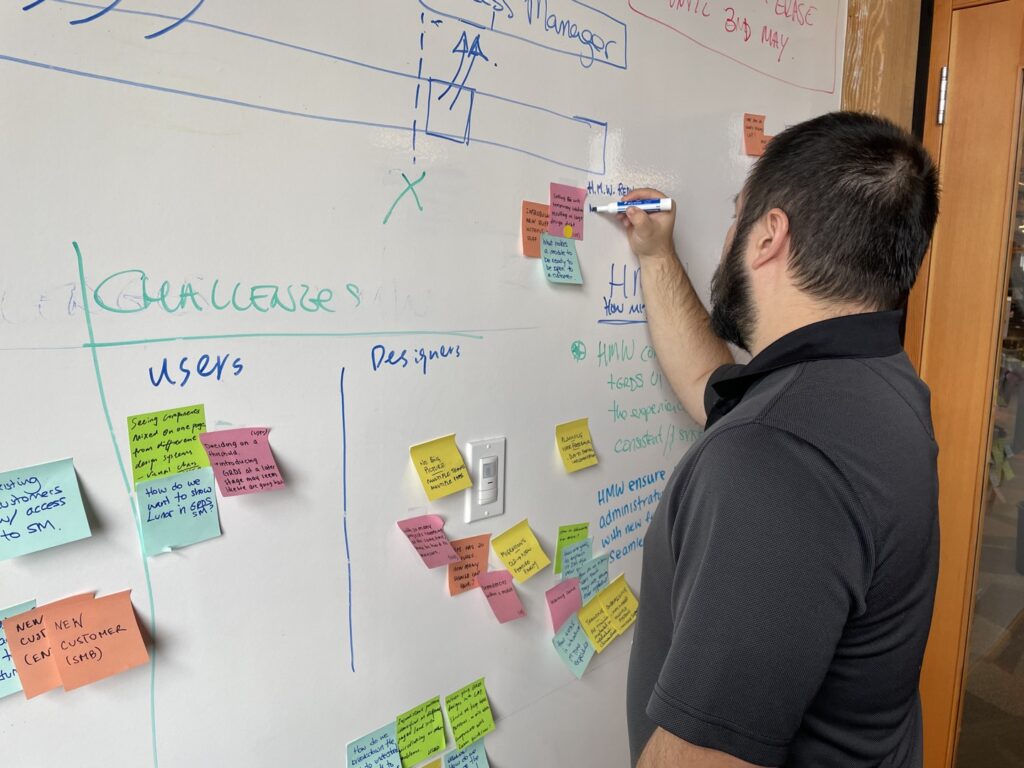Vision, Strategy, and Design Leadership
Challenge
- The existing platform was fragmented into several applications with no SSO
- A low-quality UX and poor information architecture required training for users.
- Existing platform unsuitable for customer-facing use
- UX force weakened by lack of structure, governance, and clear user-centred-design process.
Approach
- Conducted extensive research and gathered insights to identify key challenges
- Coordinated and engaged with multiple stakeholders to define vision and approach.
- Carry out a series of discovery workshops to shape the user experience
- Championed the user-centred design through Design thinking practises.
- Developed a process to drive the design work in partnership with stakeholders.
Role: UX Design Lead, Design Manager \ Team size: 8 designers
Discovery
I started by conducting Discovery Canvas workshops with leadership stakeholders to define the program’s vision, key objectives, audience and metrics.
Then, I gathered existing research personas and interviewed stakeholders to gain a holistic vision of the challenges and align with Product, Architecture and Development.
Also, to improve alignment with Product and Architecture, I conducted a task analysis and created a journey map that gathers the product’s end-to-end lifecycle.
The discovery included a cross-company Information Architecture study, including card sorting and tree tests, and defined a base IA based on current mental models.


Ideation, prototype & test


I carried out a design sprint to define design direction and foundational work to guide the team
I defined the initial user test vision and proposal with customers, using their insights to develop a strategic approach.
A key part of the program was to define the design principles, identify new personas, and define the platform’s experiences and applications.
I also aligned with the design system and implemented a governance system to achieve consistency and create team efficiencies.
To support the design output I cooordinated the work with the different teams through a robust UCD process and documentation hub.
Design to scale and growth
The team: I helped build an initial team focused on working in the administration area. The team was spread out between London and Vancouver, which was challenging due to the limited overlap between time zones. For this reason, creating thorough design documentation and strong communication was crucial for scaling the design activity. Running ideation workshops to ensure an aligned vision and regular Shows & Tells and design critique session, has been fundamental for our achivements. However working with the teams was one of the most rewarding activities of these program, their fantastic job and commitment to program was critical for its success.


Design Documentation: To ensure consistency and excellence in design, a significant portion of the design time was dedicated to documenting design patterns and behaviours defining the platform’s experience. This allowed any designer to understand the essence and principles behind the proposed experience and naturally align to it.




Agile framework: I collaborated with the teams under an agile framework, using tools like Jira, Confluence, and Productboard, and carrying out sprints and their ceremonies regularly, help define realistic timeframes, understand capacity and estimate the work more accurately. Also, working on an agile framework enabled the teams to align, communicate, and understand the day-to-day view and the strategic workstreams ahead.

Results
We created of a new user experience and design language that would be the foundational work for compony-wide digital transformations
My work was supported by strong relationships with product, architecture, and development capabilities that translate into more efficient use of design capabilities. Increase visibility and exposure of security products to other customer segments and vice versa.
One of the aspects that makes me most proud of this experience is that we adopted and implemented a UCD within the business, I established a cadence for testing often, communicating customer insight, and creating digital products that truly aligned with our customers’ needs


Learnings
Constant communication and alignment with stakeholders was crucial to our success in creating exceptional user experiences that cater for wide range of needs.
Collaborating with the Product team from the project’s outset to establish working methods and roles and educating them about a user-centred design approach was essential to navigating the challenging times during development when different views were on the table.
Finally, User research was critical for us to define our strategic approach and to foster collaboration with the Product, Architecture, and Development teams. Involving design from the beginning of a project is necessary to provide input on strategy, planning, and architectural design.



